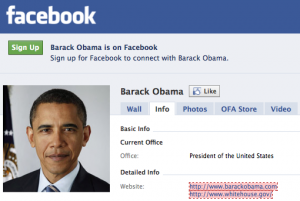 One of the key attributes of social marketing that Barack Obama implemented into his presidential campaign was the idea of connecting with people through various technology in an authentic and compassionate way. Having a solid brand with something interesting and passionate to say about it will lead to “data abstraction” (spin-offs or mash-ups) of your content you generate (Nowell, 2008). The idea is to recruit evangelists, motivate them to spread your positive stories through word of mouth, build communities around your brand and monitor the viral effect it has on your audience (Nowell, 2008).
One of the key attributes of social marketing that Barack Obama implemented into his presidential campaign was the idea of connecting with people through various technology in an authentic and compassionate way. Having a solid brand with something interesting and passionate to say about it will lead to “data abstraction” (spin-offs or mash-ups) of your content you generate (Nowell, 2008). The idea is to recruit evangelists, motivate them to spread your positive stories through word of mouth, build communities around your brand and monitor the viral effect it has on your audience (Nowell, 2008).
Obama’s campaign leveraged tools and strategies of social media marketing to coordinate and invigorate millions of people at the grass roots level, engage and interact with people who showed little participation in the political process and turn them into active members, and raise hundreds of millions of dollars – often donated from ordinary citizens (Bullock & Leary, 2008). Obama was able to do all of this by creating and making available his content for his community followers through a wide variety of technology and an integrated communications marketing plan. *multi-channel
On Obama’s website, he has many links to connect his audience to his content, including Obama mobile, “Show your support” for Obama and the Democratic Party on Facebook, and an large list of social media under “Obama everywhere”. What Obama practiced with these media, however, was a two-way conversation with his followers. Within the first two months of launching his Twitter profile in 2008, Obama was being followed by 46,000 people and had 43,000 followers. Mrs. Hillary Clinton at the time was following zero and had just over 3,000 followers (Bullock & Leary, 2008). Bloggers started blogging about how Obama was following them, which caused excitement in the marketplace that lead people to talk about him online and generate almost a celebrity-like status for the candidate.
The Voice of a Grassroots Movement site is an example of viral marketing that resulted from Obama’s campaign. This movement is where different artists come together to create a music for a CD titled “Yes, We Can”. Musical artists such as Sheryl Crow and Stevie Wonder donated songs to the CD to be bought online by followers and supporters on the www.BarackObama.com website, where proceeds go to the Barack Obama campaign. Similarly, Obama’s active presence on Dipdive.com, a video playing site, led Black Eyed Peas’s singer Will.i.am to remix Obama’s “Yes, We Can” speech into a musical montage. At the time of Obama’s election, the video on YouTube was viewed over 10,000,000 times!
So, what is the main idea behind all of this? It is to start a conversation and engage and interact enough with your audience on a personal level so the market will talk about you. This is where you build your expert status (Bullock & Leary, 2008). The thing to remember is to concentrate on sharing your ideas and vision in ways that move people to act on your behalf. It is crucial to think creatively about how you can interact and engage with the people around you to help create content, which will in turn help you draw some attention and credibility to your web presence (Bullock & Leary, 2008). Ultimately, you can direct people where you want to go!
Sources
Bullock, David & Brian Leary. (2008). “Barack Obama’s Social Media Lessons for Business.” Lulu Inc. – Global Market Distribution. Tennessee, U.S.A.
Nowell, David. (2008). “Marketing on the Web.” Nowell Enterprises.
